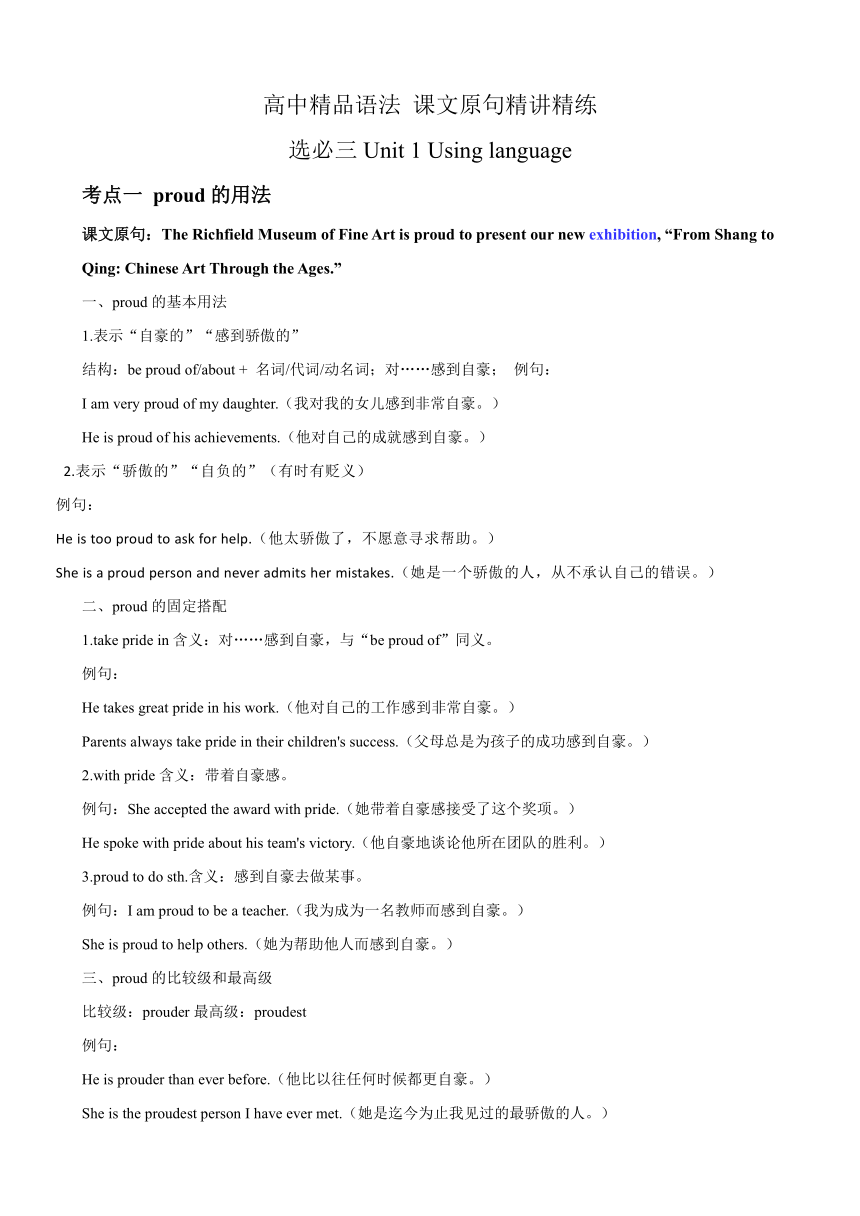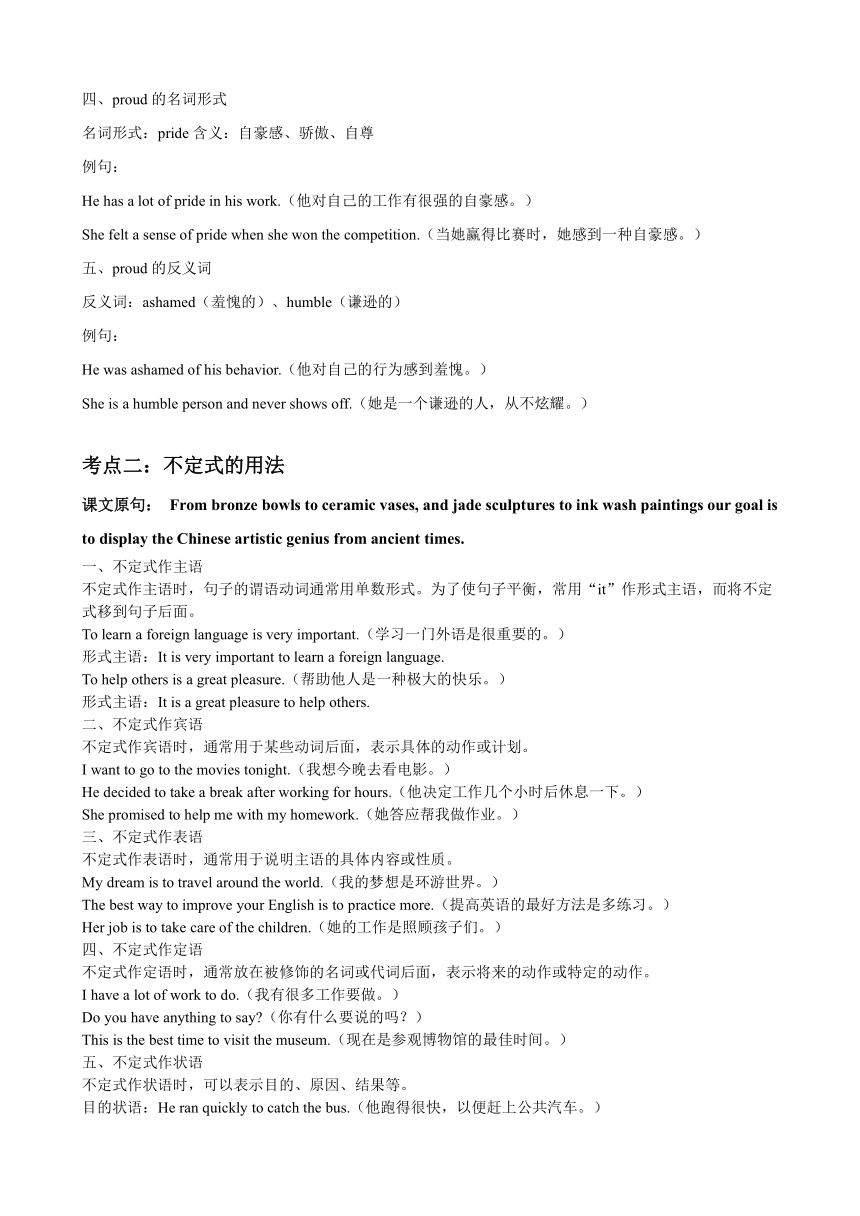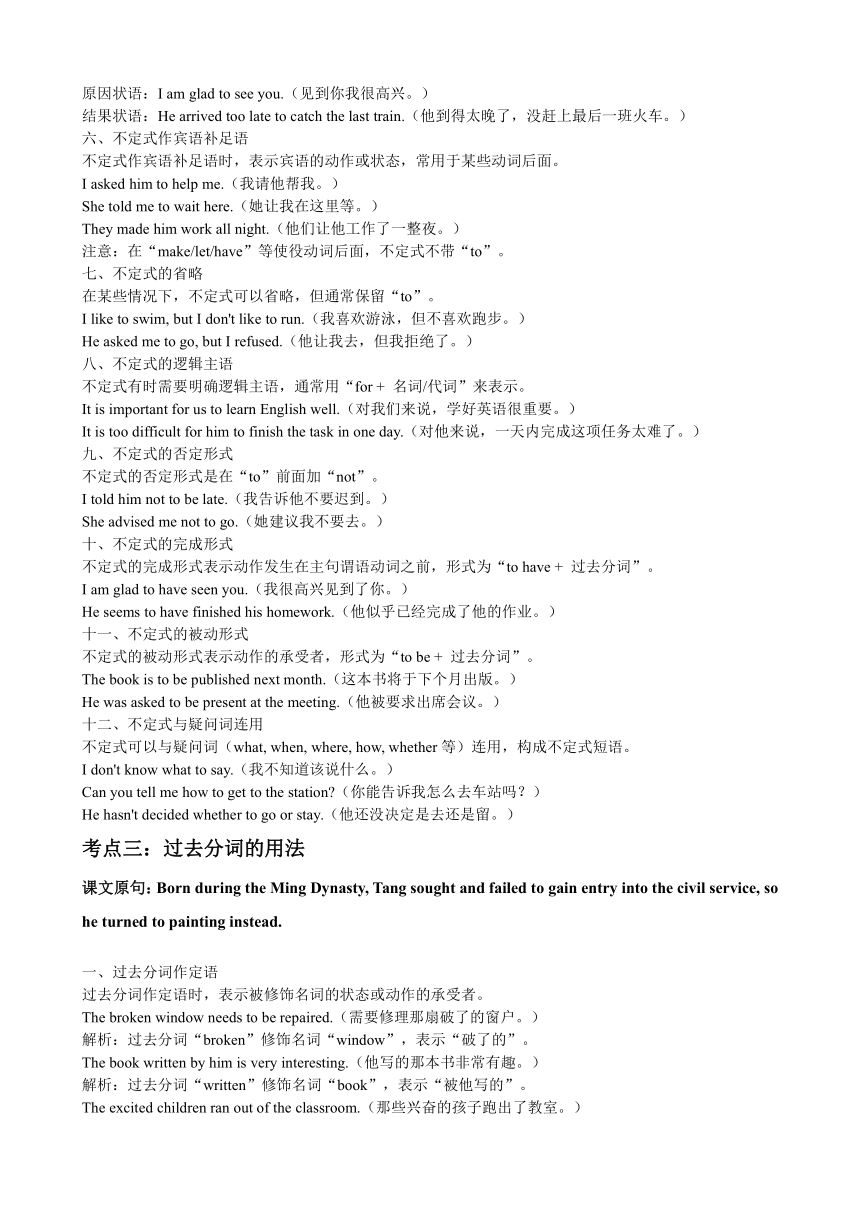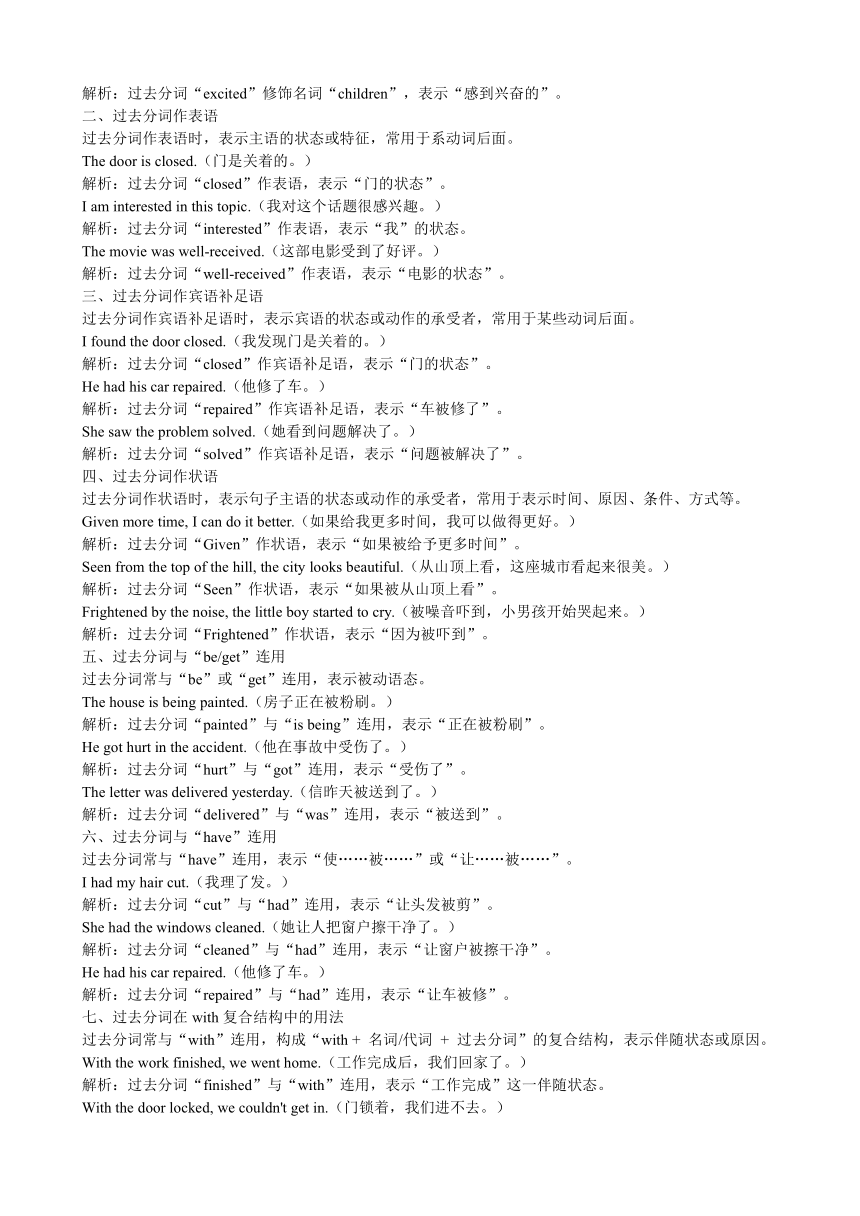Unit1 Art Using language 课文原句精讲精练(含答案)-2024-2025学年高中英语人教版(2019)选择性必修第三册
文档属性
| 名称 | Unit1 Art Using language 课文原句精讲精练(含答案)-2024-2025学年高中英语人教版(2019)选择性必修第三册 |  | |
| 格式 | docx | ||
| 文件大小 | 31.8KB | ||
| 资源类型 | 教案 | ||
| 版本资源 | 人教版(2019) | ||
| 科目 | 英语 | ||
| 更新时间 | 2025-02-11 12:39:23 | ||
图片预览




文档简介
高中精品语法 课文原句精讲精练
选必三Unit 1 Using language
考点一 proud的用法
课文原句:The Richfield Museum of Fine Art is proud to present our new exhibition, “From Shang to Qing: Chinese Art Through the Ages.”
一、proud的基本用法
1.表示“自豪的”“感到骄傲的”
结构:be proud of/about + 名词/代词/动名词;对……感到自豪; 例句:
I am very proud of my daughter.(我对我的女儿感到非常自豪。)
He is proud of his achievements.(他对自己的成就感到自豪。)
2.表示“骄傲的”“自负的”(有时有贬义)
例句:
He is too proud to ask for help.(他太骄傲了,不愿意寻求帮助。)
She is a proud person and never admits her mistakes.(她是一个骄傲的人,从不承认自己的错误。)
二、proud的固定搭配
1.take pride in含义:对……感到自豪,与“be proud of”同义。
例句:
He takes great pride in his work.(他对自己的工作感到非常自豪。)
Parents always take pride in their children's success.(父母总是为孩子的成功感到自豪。)
2.with pride含义:带着自豪感。
例句:She accepted the award with pride.(她带着自豪感接受了这个奖项。)
He spoke with pride about his team's victory.(他自豪地谈论他所在团队的胜利。)
3.proud to do sth.含义:感到自豪去做某事。
例句:I am proud to be a teacher.(我为成为一名教师而感到自豪。)
She is proud to help others.(她为帮助他人而感到自豪。)
三、proud的比较级和最高级
比较级:prouder最高级:proudest
例句:
He is prouder than ever before.(他比以往任何时候都更自豪。)
She is the proudest person I have ever met.(她是迄今为止我见过的最骄傲的人。)
四、proud的名词形式
名词形式:pride含义:自豪感、骄傲、自尊
例句:
He has a lot of pride in his work.(他对自己的工作有很强的自豪感。)
She felt a sense of pride when she won the competition.(当她赢得比赛时,她感到一种自豪感。)
五、proud的反义词
反义词:ashamed(羞愧的)、humble(谦逊的)
例句:
He was ashamed of his behavior.(他对自己的行为感到羞愧。)
She is a humble person and never shows off.(她是一个谦逊的人,从不炫耀。)
考点二:不定式的用法
课文原句: From bronze bowls to ceramic vases, and jade sculptures to ink wash paintings our goal is to display the Chinese artistic genius from ancient times.
一、不定式作主语
不定式作主语时,句子的谓语动词通常用单数形式。为了使句子平衡,常用“it”作形式主语,而将不定式移到句子后面。
To learn a foreign language is very important.(学习一门外语是很重要的。)
形式主语:It is very important to learn a foreign language.
To help others is a great pleasure.(帮助他人是一种极大的快乐。)
形式主语:It is a great pleasure to help others.
二、不定式作宾语
不定式作宾语时,通常用于某些动词后面,表示具体的动作或计划。
I want to go to the movies tonight.(我想今晚去看电影。)
He decided to take a break after working for hours.(他决定工作几个小时后休息一下。)
She promised to help me with my homework.(她答应帮我做作业。)
三、不定式作表语
不定式作表语时,通常用于说明主语的具体内容或性质。
My dream is to travel around the world.(我的梦想是环游世界。)
The best way to improve your English is to practice more.(提高英语的最好方法是多练习。)
Her job is to take care of the children.(她的工作是照顾孩子们。)
四、不定式作定语
不定式作定语时,通常放在被修饰的名词或代词后面,表示将来的动作或特定的动作。
I have a lot of work to do.(我有很多工作要做。)
Do you have anything to say (你有什么要说的吗?)
This is the best time to visit the museum.(现在是参观博物馆的最佳时间。)
五、不定式作状语
不定式作状语时,可以表示目的、原因、结果等。
目的状语:He ran quickly to catch the bus.(他跑得很快,以便赶上公共汽车。)
原因状语:I am glad to see you.(见到你我很高兴。)
结果状语:He arrived too late to catch the last train.(他到得太晚了,没赶上最后一班火车。)
六、不定式作宾语补足语
不定式作宾语补足语时,表示宾语的动作或状态,常用于某些动词后面。
I asked him to help me.(我请他帮我。)
She told me to wait here.(她让我在这里等。)
They made him work all night.(他们让他工作了一整夜。)
注意:在“make/let/have”等使役动词后面,不定式不带“to”。
七、不定式的省略
在某些情况下,不定式可以省略,但通常保留“to”。
I like to swim, but I don't like to run.(我喜欢游泳,但不喜欢跑步。)
He asked me to go, but I refused.(他让我去,但我拒绝了。)
八、不定式的逻辑主语
不定式有时需要明确逻辑主语,通常用“for + 名词/代词”来表示。
It is important for us to learn English well.(对我们来说,学好英语很重要。)
It is too difficult for him to finish the task in one day.(对他来说,一天内完成这项任务太难了。)
九、不定式的否定形式
不定式的否定形式是在“to”前面加“not”。
I told him not to be late.(我告诉他不要迟到。)
She advised me not to go.(她建议我不要去。)
十、不定式的完成形式
不定式的完成形式表示动作发生在主句谓语动词之前,形式为“to have + 过去分词”。
I am glad to have seen you.(我很高兴见到了你。)
He seems to have finished his homework.(他似乎已经完成了他的作业。)
十一、不定式的被动形式
不定式的被动形式表示动作的承受者,形式为“to be + 过去分词”。
The book is to be published next month.(这本书将于下个月出版。)
He was asked to be present at the meeting.(他被要求出席会议。)
十二、不定式与疑问词连用
不定式可以与疑问词(what, when, where, how, whether等)连用,构成不定式短语。
I don't know what to say.(我不知道该说什么。)
Can you tell me how to get to the station (你能告诉我怎么去车站吗?)
He hasn't decided whether to go or stay.(他还没决定是去还是留。)
考点三:过去分词的用法
课文原句:Born during the Ming Dynasty, Tang sought and failed to gain entry into the civil service, so he turned to painting instead.
一、过去分词作定语
过去分词作定语时,表示被修饰名词的状态或动作的承受者。
The broken window needs to be repaired.(需要修理那扇破了的窗户。)
解析:过去分词“broken”修饰名词“window”,表示“破了的”。
The book written by him is very interesting.(他写的那本书非常有趣。)
解析:过去分词“written”修饰名词“book”,表示“被他写的”。
The excited children ran out of the classroom.(那些兴奋的孩子跑出了教室。)
解析:过去分词“excited”修饰名词“children”,表示“感到兴奋的”。
二、过去分词作表语
过去分词作表语时,表示主语的状态或特征,常用于系动词后面。
The door is closed.(门是关着的。)
解析:过去分词“closed”作表语,表示“门的状态”。
I am interested in this topic.(我对这个话题很感兴趣。)
解析:过去分词“interested”作表语,表示“我”的状态。
The movie was well-received.(这部电影受到了好评。)
解析:过去分词“well-received”作表语,表示“电影的状态”。
三、过去分词作宾语补足语
过去分词作宾语补足语时,表示宾语的状态或动作的承受者,常用于某些动词后面。
I found the door closed.(我发现门是关着的。)
解析:过去分词“closed”作宾语补足语,表示“门的状态”。
He had his car repaired.(他修了车。)
解析:过去分词“repaired”作宾语补足语,表示“车被修了”。
She saw the problem solved.(她看到问题解决了。)
解析:过去分词“solved”作宾语补足语,表示“问题被解决了”。
四、过去分词作状语
过去分词作状语时,表示句子主语的状态或动作的承受者,常用于表示时间、原因、条件、方式等。
Given more time, I can do it better.(如果给我更多时间,我可以做得更好。)
解析:过去分词“Given”作状语,表示“如果被给予更多时间”。
Seen from the top of the hill, the city looks beautiful.(从山顶上看,这座城市看起来很美。)
解析:过去分词“Seen”作状语,表示“如果被从山顶上看”。
Frightened by the noise, the little boy started to cry.(被噪音吓到,小男孩开始哭起来。)
解析:过去分词“Frightened”作状语,表示“因为被吓到”。
五、过去分词与“be/get”连用
过去分词常与“be”或“get”连用,表示被动语态。
The house is being painted.(房子正在被粉刷。)
解析:过去分词“painted”与“is being”连用,表示“正在被粉刷”。
He got hurt in the accident.(他在事故中受伤了。)
解析:过去分词“hurt”与“got”连用,表示“受伤了”。
The letter was delivered yesterday.(信昨天被送到了。)
解析:过去分词“delivered”与“was”连用,表示“被送到”。
六、过去分词与“have”连用
过去分词常与“have”连用,表示“使……被……”或“让……被……”。
I had my hair cut.(我理了发。)
解析:过去分词“cut”与“had”连用,表示“让头发被剪”。
She had the windows cleaned.(她让人把窗户擦干净了。)
解析:过去分词“cleaned”与“had”连用,表示“让窗户被擦干净”。
He had his car repaired.(他修了车。)
解析:过去分词“repaired”与“had”连用,表示“让车被修”。
七、过去分词在with复合结构中的用法
过去分词常与“with”连用,构成“with + 名词/代词 + 过去分词”的复合结构,表示伴随状态或原因。
With the work finished, we went home.(工作完成后,我们回家了。)
解析:过去分词“finished”与“with”连用,表示“工作完成”这一伴随状态。
With the door locked, we couldn't get in.(门锁着,我们进不去。)
解析:过去分词“locked”与“with”连用,表示“门锁着”这一原因。
With the children asleep, she began to prepare dinner.(孩子们睡着了,她开始准备晚餐。)
解析:过去分词“asleep”与“with”连用,表示“孩子们睡着”这一伴随状态。
八、过去分词与“make/get/keep”连用
过去分词常与“make/get/keep”等动词连用,表示“使……处于某种状态”。
The news made him happy.(这个消息使他很高兴。)
解析:过去分词“happy”与“made”连用,表示“使他高兴”。
The story got him excited.(这个故事让他很兴奋。)
解析:过去分词“excited”与“got”连用,表示“使他兴奋”。
The teacher kept the students busy.(老师让学生们忙个不停。)
解析:过去分词“busy”与“kept”连用,表示“让学生们忙个不停”。
考点四:现在分词的用法
课文原句:In time, he gained recognition as one of the greatest artists China has ever known. This painting, showing high mountains, trees, and houses covered in snow, was made with extraordinary skill.
现在分词(Present Participle)是英语中一种重要的非谓语动词形式,通常由动词的现在分词形式构成(规则动词为“动词原形 + -ing”,不规则动词也有相应的-ing形式)。现在分词在句子中有多种用法,包括作定语、表语、宾语补足语和状语等。以下是现在分词的常见用法及例句,帮助你更好地理解和掌握:
一、现在分词作定语
现在分词作定语时,表示被修饰名词正在进行的动作或特征。
The running water is very cold.(流动的水很冷。)
解析:现在分词“running”修饰名词“water”,表示“正在流动的”。
The smiling boy is my brother.(那个微笑的男孩是我的弟弟。)
解析:现在分词“smiling”修饰名词“boy”,表示“正在微笑的”。
The falling leaves covered the ground.(飘落的树叶覆盖了地面。)
解析:现在分词“falling”修饰名词“leaves”,表示“正在飘落的”。
二、现在分词作表语
现在分词作表语时,表示主语正在进行的动作或状态,常用于系动词后面。
The situation is getting worse.(情况正在变得更糟。)
解析:现在分词“getting”作表语,表示“正在变得更糟”。
He is always complaining about something.(他总是在抱怨一些事情。)
解析:现在分词“complaining”作表语,表示“正在抱怨”。
The movie is very exciting.(这部电影非常令人兴奋。)
解析:现在分词“exciting”作表语,表示“令人兴奋的”。
三、现在分词作宾语补足语
现在分词作宾语补足语时,表示宾语正在进行的动作,常用于某些动词后面。
I saw him running in the park.(我看到他在公园里跑步。)
解析:现在分词“running”作宾语补足语,表示“他正在跑步”。
She kept the children playing in the garden.(她让孩子们在花园里玩耍。)
解析:现在分词“playing”作宾语补足语,表示“孩子们正在玩耍”。
He left the door open.(他让门开着。)
解析:现在分词“open”作宾语补足语,表示“门是开着的”。
四、现在分词作状语
现在分词作状语时,表示句子主语正在进行的动作或状态,常用于表示时间、原因、条件、方式等。
Walking in the park, I saw an old friend.(在公园散步时,我看到了一位老朋友。)
解析:现在分词“Walking”作状语,表示“在散步时”。
Feeling tired, I went to bed early.(感到疲倦,我早早地去睡觉了。)
解析:现在分词“Feeling”作状语,表示“因为感到疲倦”。
Without thinking, he answered the question.(没有思考,他回答了问题。)
解析:现在分词“thinking”作状语,表示“没有思考”。
五、现在分词与“be/get”连用
现在分词常与“be”或“get”连用,表示进行时态或状态。
The children are playing in the garden.(孩子们正在花园里玩耍。)
解析:现在分词“playing”与“are”连用,表示“正在玩耍”。
He is getting tired of this job.(他开始厌倦这份工作了。)
解析:现在分词“tired”与“is getting”连用,表示“开始厌倦”。
The meeting is going on.(会议正在进行。)
解析:现在分词“going”与“is”连用,表示“正在进行”。
六、现在分词与“have”连用
现在分词常与“have”连用,表示“使……处于某种状态”或“让……做某事”。
I had the children playing in the garden.(我让孩子们在花园里玩耍。)
解析:现在分词“playing”与“had”连用,表示“让孩子们玩耍”。
She had the door open.(她让门开着。)
解析:现在分词“open”与“had”连用,表示“让门开着”。
He had the lights on all night.(他整晚都开着灯。)
解析:现在分词“on”与“had”连用,表示“让灯开着”。
七、现在分词与“with”连用
现在分词常与“with”连用,构成“with + 名词/代词 + 现在分词”的复合结构,表示伴随状态或原因。
With the children playing in the garden, she sat on the bench.(孩子们在花园里玩耍时,她坐在长椅上。)
解析:现在分词“playing”与“with”连用,表示“孩子们正在玩耍”这一伴随状态。
With the door open, he left the room.(门开着,他离开了房间。)
解析:现在分词“open”与“with”连用,表示“门开着”这一伴随状态。
With the music playing in the background, we enjoyed our dinner.(背景音乐播放时,我们享受了晚餐。)
解析:现在分词“playing”与“with”连用,表示“音乐正在播放”这一伴随状态。
八、现在分词与“keep”连用
现在分词常与“keep”连用,表示“使……处于某种状态”或“让……继续做某事”。
The teacher kept the students working on the project.(老师让学生们继续做这个项目。)
解析:现在分词“working”与“kept”连用,表示“让……继续做”。
He kept the lights on all night.(他整晚都开着灯。)
解析:现在分词“on”与“kept”连用,表示“让灯开着”。
She kept the window open.(她让窗户开着。)
解析:现在分词“open”与“kept”连用,表示“让窗户开着”。
考点四:be thought to do 类似用法
课文原句:Some of the items on display are thought to have come from the collection of Emperor Qianlong(1711-1799), a great admirer of Shang Dynasty bronze.
“be thought to do”是一种常见的英语表达,表示“被认为……做……”,其中“thought”是“think”的过去分词形式,与“be”构成被动语态,表示一种推测或普遍的看法。以下是与“be thought to do”类似的用法及相关解释:
1. be believed to do含义:被认为……做……
例句:He is believed to have left the country.(他被认为已经离开了这个国家。)
2. be supposed to do含义:被认为应该……做……
例句:You are supposed to arrive on time.(你被认为应该按时到达。)
3. be said to do含义:据说……做……
例句:He is said to be very talented.(据说他很有才华。)
4. be expected to do含义:被期望……做……
例句:She is expected to win the championship.(她被期望赢得冠军。)
5. be assumed to do含义:被假设……做……
例句:It is assumed to be safe.(它被认为很安全。)
6. be considered to do含义:被认为……做……
例句:He is considered to be the best candidate.(他被认为是最好的候选人。)
7. be rumored to do含义:有传言说……做……
例句:He is rumored to be involved in the scandal.(有传言说他卷入了丑闻。)
8. be reported to do含义:据报道……做……
例句:It is reported to have been a successful event.(据报道,这是一个成功的活动。)
配套练习
1.He is always complaining about his job, but he is actually very _______ (proud) of it.
2.She is so _______ (proud) that she never asks for help.
3.He is _______ (proud) to have been chosen for the national team.
4.Parents always take great _______ (proud) in their children's achievements.
5.She felt a sense of _______ (proud) when she received the award.
6.I really want _____ (spend) more time with my family this weekend.
7.It’s important _____ (learn) a new language in today’s globalized world.
8.He is too tired _____ (continue) working without a break.
9.She decided _____ (take) a gap year to travel around the world.
10.The teacher asked the students _____ (finish) their homework before Friday.
11.The window ________ (break) by the strong wind yesterday.
12.The book ________ (write) by the famous author was sold out quickly.
13.The problem ________ (discuss) at the meeting yesterday is still unsolved.
14.The house ________ (build) last year is now being used as a community center.
15.The letter ________ (send) to the wrong address was returned to the sender.
16.The little girl stood there, with tears ________ (roll) down her face.
17.________ (compare) with the size of the whole earth, the highest mountain does not seem too high.
18.The man was seen ________ (rush) out of the building when the fire broke out.
19.The book is interesting enough to keep the children ________ (read) for hours.
20.The old man sat in his chair, ________ (smoke) a cigarette.
21. The old castle ___________ (date) back to the 14th century.
22. This new type of medicine ___________ (cure) many diseases.
23. The scientist ___________ (discover) a new planet in the near future.
24. The novel ___________ (write) by a famous author.
25. The project ___________ (complete) by the end of this month.
答案:
答案:proud 解析:这里考查“be proud of”结构,表示“对……感到自豪”。
答案:proud解析:这里考查“proud”作为形容词表示“骄傲的”“自负的”,常用于“too...to...”结构中。
答案:proud解析:这里考查“be proud to do sth.”结构,表示“对做某事感到自豪”。
答案:pride解析:这里考查“take pride in”短语,表示“对……感到自豪”。注意“proud”的名词形式是“pride”。
答案:pride解析:这里考查“a sense of pride”短语,表示“一种自豪感”。
答案:to spend解析:want to do sth. 是固定搭配,表示“想要做某事”。
答案:to learn解析:It’s + 形容词 + to do sth. 是固定句型,其中不定式作真正主语,it 是形式主语。
答案:to continue解析:too...to... 结构中,to do sth. 表示“太……而不能……”,表示否定意义。
答案:to take解析:decide to do sth. 是固定搭配,表示“决定做某事”。
答案:to finish解析:ask sb. to do sth. 是固定搭配,表示“要求某人做某事”。
11.was broken12.written13.discussed14.built15.Sent
16.rolling解析:这里考查的是现在分词作宾语补足语。with复合结构中,tears和roll之间是主动关系,表示“眼泪滚落下来”,因此用现在分词rolling。
pared解析:这里考查的是过去分词作状语。compare与主语the highest mountain之间是被动关系,表示“与整个地球相比”,因此用过去分词compared。
18.rushing解析:这里考查的是现在分词作宾语补足语。see sb. doing sth.表示“看到某人正在做某事”,rush与the man之间是主动关系,因此用现在分词rushing。
19.reading解析:这里考查的是现在分词作宾语补足语。keep sb. doing sth.表示“让某人一直做某事”,read与the children之间是主动关系,因此用现在分词reading。
20.smoking解析:这里考查的是现在分词作状语。smoke与the old man之间是主动关系,表示“一边抽烟一边坐着”,因此用现在分词smoking。
答案: is thought to date解析: “be thought to do sth.”表示“被认为做某事”。这里表示“这座古老的城堡被认为可以追溯到14世纪”,“date back to”表示“追溯到”,用动词原形。
答案: is believed to cure解析: “be believed to do sth.”表示“被认为做某事”,与“be thought to do sth.”类似。这里表示“这种新药被认为可以治愈许多疾病”,用动词原形。
答案: is expected to discover解析: “be expected to do sth.”表示“被期望做某事”。这里表示“这位科学家被期望在未来不久会发现一颗新行星”,用动词原形。
答案: is said to be written解析: “be said to do sth.”表示“据说做某事”。这里表示“这部小说据说是由一位著名作家写的”,因为“write”与“novel”之间是被动关系,所以用“be written”。
答案: is supposed to be completed解析: “be supposed to do sth.”表示“应该做某事”。这里表示“这个项目应该在本月底完成”,因为“complete”与“project”之间是被动关系,所以用“be completed”。
选必三Unit 1 Using language
考点一 proud的用法
课文原句:The Richfield Museum of Fine Art is proud to present our new exhibition, “From Shang to Qing: Chinese Art Through the Ages.”
一、proud的基本用法
1.表示“自豪的”“感到骄傲的”
结构:be proud of/about + 名词/代词/动名词;对……感到自豪; 例句:
I am very proud of my daughter.(我对我的女儿感到非常自豪。)
He is proud of his achievements.(他对自己的成就感到自豪。)
2.表示“骄傲的”“自负的”(有时有贬义)
例句:
He is too proud to ask for help.(他太骄傲了,不愿意寻求帮助。)
She is a proud person and never admits her mistakes.(她是一个骄傲的人,从不承认自己的错误。)
二、proud的固定搭配
1.take pride in含义:对……感到自豪,与“be proud of”同义。
例句:
He takes great pride in his work.(他对自己的工作感到非常自豪。)
Parents always take pride in their children's success.(父母总是为孩子的成功感到自豪。)
2.with pride含义:带着自豪感。
例句:She accepted the award with pride.(她带着自豪感接受了这个奖项。)
He spoke with pride about his team's victory.(他自豪地谈论他所在团队的胜利。)
3.proud to do sth.含义:感到自豪去做某事。
例句:I am proud to be a teacher.(我为成为一名教师而感到自豪。)
She is proud to help others.(她为帮助他人而感到自豪。)
三、proud的比较级和最高级
比较级:prouder最高级:proudest
例句:
He is prouder than ever before.(他比以往任何时候都更自豪。)
She is the proudest person I have ever met.(她是迄今为止我见过的最骄傲的人。)
四、proud的名词形式
名词形式:pride含义:自豪感、骄傲、自尊
例句:
He has a lot of pride in his work.(他对自己的工作有很强的自豪感。)
She felt a sense of pride when she won the competition.(当她赢得比赛时,她感到一种自豪感。)
五、proud的反义词
反义词:ashamed(羞愧的)、humble(谦逊的)
例句:
He was ashamed of his behavior.(他对自己的行为感到羞愧。)
She is a humble person and never shows off.(她是一个谦逊的人,从不炫耀。)
考点二:不定式的用法
课文原句: From bronze bowls to ceramic vases, and jade sculptures to ink wash paintings our goal is to display the Chinese artistic genius from ancient times.
一、不定式作主语
不定式作主语时,句子的谓语动词通常用单数形式。为了使句子平衡,常用“it”作形式主语,而将不定式移到句子后面。
To learn a foreign language is very important.(学习一门外语是很重要的。)
形式主语:It is very important to learn a foreign language.
To help others is a great pleasure.(帮助他人是一种极大的快乐。)
形式主语:It is a great pleasure to help others.
二、不定式作宾语
不定式作宾语时,通常用于某些动词后面,表示具体的动作或计划。
I want to go to the movies tonight.(我想今晚去看电影。)
He decided to take a break after working for hours.(他决定工作几个小时后休息一下。)
She promised to help me with my homework.(她答应帮我做作业。)
三、不定式作表语
不定式作表语时,通常用于说明主语的具体内容或性质。
My dream is to travel around the world.(我的梦想是环游世界。)
The best way to improve your English is to practice more.(提高英语的最好方法是多练习。)
Her job is to take care of the children.(她的工作是照顾孩子们。)
四、不定式作定语
不定式作定语时,通常放在被修饰的名词或代词后面,表示将来的动作或特定的动作。
I have a lot of work to do.(我有很多工作要做。)
Do you have anything to say (你有什么要说的吗?)
This is the best time to visit the museum.(现在是参观博物馆的最佳时间。)
五、不定式作状语
不定式作状语时,可以表示目的、原因、结果等。
目的状语:He ran quickly to catch the bus.(他跑得很快,以便赶上公共汽车。)
原因状语:I am glad to see you.(见到你我很高兴。)
结果状语:He arrived too late to catch the last train.(他到得太晚了,没赶上最后一班火车。)
六、不定式作宾语补足语
不定式作宾语补足语时,表示宾语的动作或状态,常用于某些动词后面。
I asked him to help me.(我请他帮我。)
She told me to wait here.(她让我在这里等。)
They made him work all night.(他们让他工作了一整夜。)
注意:在“make/let/have”等使役动词后面,不定式不带“to”。
七、不定式的省略
在某些情况下,不定式可以省略,但通常保留“to”。
I like to swim, but I don't like to run.(我喜欢游泳,但不喜欢跑步。)
He asked me to go, but I refused.(他让我去,但我拒绝了。)
八、不定式的逻辑主语
不定式有时需要明确逻辑主语,通常用“for + 名词/代词”来表示。
It is important for us to learn English well.(对我们来说,学好英语很重要。)
It is too difficult for him to finish the task in one day.(对他来说,一天内完成这项任务太难了。)
九、不定式的否定形式
不定式的否定形式是在“to”前面加“not”。
I told him not to be late.(我告诉他不要迟到。)
She advised me not to go.(她建议我不要去。)
十、不定式的完成形式
不定式的完成形式表示动作发生在主句谓语动词之前,形式为“to have + 过去分词”。
I am glad to have seen you.(我很高兴见到了你。)
He seems to have finished his homework.(他似乎已经完成了他的作业。)
十一、不定式的被动形式
不定式的被动形式表示动作的承受者,形式为“to be + 过去分词”。
The book is to be published next month.(这本书将于下个月出版。)
He was asked to be present at the meeting.(他被要求出席会议。)
十二、不定式与疑问词连用
不定式可以与疑问词(what, when, where, how, whether等)连用,构成不定式短语。
I don't know what to say.(我不知道该说什么。)
Can you tell me how to get to the station (你能告诉我怎么去车站吗?)
He hasn't decided whether to go or stay.(他还没决定是去还是留。)
考点三:过去分词的用法
课文原句:Born during the Ming Dynasty, Tang sought and failed to gain entry into the civil service, so he turned to painting instead.
一、过去分词作定语
过去分词作定语时,表示被修饰名词的状态或动作的承受者。
The broken window needs to be repaired.(需要修理那扇破了的窗户。)
解析:过去分词“broken”修饰名词“window”,表示“破了的”。
The book written by him is very interesting.(他写的那本书非常有趣。)
解析:过去分词“written”修饰名词“book”,表示“被他写的”。
The excited children ran out of the classroom.(那些兴奋的孩子跑出了教室。)
解析:过去分词“excited”修饰名词“children”,表示“感到兴奋的”。
二、过去分词作表语
过去分词作表语时,表示主语的状态或特征,常用于系动词后面。
The door is closed.(门是关着的。)
解析:过去分词“closed”作表语,表示“门的状态”。
I am interested in this topic.(我对这个话题很感兴趣。)
解析:过去分词“interested”作表语,表示“我”的状态。
The movie was well-received.(这部电影受到了好评。)
解析:过去分词“well-received”作表语,表示“电影的状态”。
三、过去分词作宾语补足语
过去分词作宾语补足语时,表示宾语的状态或动作的承受者,常用于某些动词后面。
I found the door closed.(我发现门是关着的。)
解析:过去分词“closed”作宾语补足语,表示“门的状态”。
He had his car repaired.(他修了车。)
解析:过去分词“repaired”作宾语补足语,表示“车被修了”。
She saw the problem solved.(她看到问题解决了。)
解析:过去分词“solved”作宾语补足语,表示“问题被解决了”。
四、过去分词作状语
过去分词作状语时,表示句子主语的状态或动作的承受者,常用于表示时间、原因、条件、方式等。
Given more time, I can do it better.(如果给我更多时间,我可以做得更好。)
解析:过去分词“Given”作状语,表示“如果被给予更多时间”。
Seen from the top of the hill, the city looks beautiful.(从山顶上看,这座城市看起来很美。)
解析:过去分词“Seen”作状语,表示“如果被从山顶上看”。
Frightened by the noise, the little boy started to cry.(被噪音吓到,小男孩开始哭起来。)
解析:过去分词“Frightened”作状语,表示“因为被吓到”。
五、过去分词与“be/get”连用
过去分词常与“be”或“get”连用,表示被动语态。
The house is being painted.(房子正在被粉刷。)
解析:过去分词“painted”与“is being”连用,表示“正在被粉刷”。
He got hurt in the accident.(他在事故中受伤了。)
解析:过去分词“hurt”与“got”连用,表示“受伤了”。
The letter was delivered yesterday.(信昨天被送到了。)
解析:过去分词“delivered”与“was”连用,表示“被送到”。
六、过去分词与“have”连用
过去分词常与“have”连用,表示“使……被……”或“让……被……”。
I had my hair cut.(我理了发。)
解析:过去分词“cut”与“had”连用,表示“让头发被剪”。
She had the windows cleaned.(她让人把窗户擦干净了。)
解析:过去分词“cleaned”与“had”连用,表示“让窗户被擦干净”。
He had his car repaired.(他修了车。)
解析:过去分词“repaired”与“had”连用,表示“让车被修”。
七、过去分词在with复合结构中的用法
过去分词常与“with”连用,构成“with + 名词/代词 + 过去分词”的复合结构,表示伴随状态或原因。
With the work finished, we went home.(工作完成后,我们回家了。)
解析:过去分词“finished”与“with”连用,表示“工作完成”这一伴随状态。
With the door locked, we couldn't get in.(门锁着,我们进不去。)
解析:过去分词“locked”与“with”连用,表示“门锁着”这一原因。
With the children asleep, she began to prepare dinner.(孩子们睡着了,她开始准备晚餐。)
解析:过去分词“asleep”与“with”连用,表示“孩子们睡着”这一伴随状态。
八、过去分词与“make/get/keep”连用
过去分词常与“make/get/keep”等动词连用,表示“使……处于某种状态”。
The news made him happy.(这个消息使他很高兴。)
解析:过去分词“happy”与“made”连用,表示“使他高兴”。
The story got him excited.(这个故事让他很兴奋。)
解析:过去分词“excited”与“got”连用,表示“使他兴奋”。
The teacher kept the students busy.(老师让学生们忙个不停。)
解析:过去分词“busy”与“kept”连用,表示“让学生们忙个不停”。
考点四:现在分词的用法
课文原句:In time, he gained recognition as one of the greatest artists China has ever known. This painting, showing high mountains, trees, and houses covered in snow, was made with extraordinary skill.
现在分词(Present Participle)是英语中一种重要的非谓语动词形式,通常由动词的现在分词形式构成(规则动词为“动词原形 + -ing”,不规则动词也有相应的-ing形式)。现在分词在句子中有多种用法,包括作定语、表语、宾语补足语和状语等。以下是现在分词的常见用法及例句,帮助你更好地理解和掌握:
一、现在分词作定语
现在分词作定语时,表示被修饰名词正在进行的动作或特征。
The running water is very cold.(流动的水很冷。)
解析:现在分词“running”修饰名词“water”,表示“正在流动的”。
The smiling boy is my brother.(那个微笑的男孩是我的弟弟。)
解析:现在分词“smiling”修饰名词“boy”,表示“正在微笑的”。
The falling leaves covered the ground.(飘落的树叶覆盖了地面。)
解析:现在分词“falling”修饰名词“leaves”,表示“正在飘落的”。
二、现在分词作表语
现在分词作表语时,表示主语正在进行的动作或状态,常用于系动词后面。
The situation is getting worse.(情况正在变得更糟。)
解析:现在分词“getting”作表语,表示“正在变得更糟”。
He is always complaining about something.(他总是在抱怨一些事情。)
解析:现在分词“complaining”作表语,表示“正在抱怨”。
The movie is very exciting.(这部电影非常令人兴奋。)
解析:现在分词“exciting”作表语,表示“令人兴奋的”。
三、现在分词作宾语补足语
现在分词作宾语补足语时,表示宾语正在进行的动作,常用于某些动词后面。
I saw him running in the park.(我看到他在公园里跑步。)
解析:现在分词“running”作宾语补足语,表示“他正在跑步”。
She kept the children playing in the garden.(她让孩子们在花园里玩耍。)
解析:现在分词“playing”作宾语补足语,表示“孩子们正在玩耍”。
He left the door open.(他让门开着。)
解析:现在分词“open”作宾语补足语,表示“门是开着的”。
四、现在分词作状语
现在分词作状语时,表示句子主语正在进行的动作或状态,常用于表示时间、原因、条件、方式等。
Walking in the park, I saw an old friend.(在公园散步时,我看到了一位老朋友。)
解析:现在分词“Walking”作状语,表示“在散步时”。
Feeling tired, I went to bed early.(感到疲倦,我早早地去睡觉了。)
解析:现在分词“Feeling”作状语,表示“因为感到疲倦”。
Without thinking, he answered the question.(没有思考,他回答了问题。)
解析:现在分词“thinking”作状语,表示“没有思考”。
五、现在分词与“be/get”连用
现在分词常与“be”或“get”连用,表示进行时态或状态。
The children are playing in the garden.(孩子们正在花园里玩耍。)
解析:现在分词“playing”与“are”连用,表示“正在玩耍”。
He is getting tired of this job.(他开始厌倦这份工作了。)
解析:现在分词“tired”与“is getting”连用,表示“开始厌倦”。
The meeting is going on.(会议正在进行。)
解析:现在分词“going”与“is”连用,表示“正在进行”。
六、现在分词与“have”连用
现在分词常与“have”连用,表示“使……处于某种状态”或“让……做某事”。
I had the children playing in the garden.(我让孩子们在花园里玩耍。)
解析:现在分词“playing”与“had”连用,表示“让孩子们玩耍”。
She had the door open.(她让门开着。)
解析:现在分词“open”与“had”连用,表示“让门开着”。
He had the lights on all night.(他整晚都开着灯。)
解析:现在分词“on”与“had”连用,表示“让灯开着”。
七、现在分词与“with”连用
现在分词常与“with”连用,构成“with + 名词/代词 + 现在分词”的复合结构,表示伴随状态或原因。
With the children playing in the garden, she sat on the bench.(孩子们在花园里玩耍时,她坐在长椅上。)
解析:现在分词“playing”与“with”连用,表示“孩子们正在玩耍”这一伴随状态。
With the door open, he left the room.(门开着,他离开了房间。)
解析:现在分词“open”与“with”连用,表示“门开着”这一伴随状态。
With the music playing in the background, we enjoyed our dinner.(背景音乐播放时,我们享受了晚餐。)
解析:现在分词“playing”与“with”连用,表示“音乐正在播放”这一伴随状态。
八、现在分词与“keep”连用
现在分词常与“keep”连用,表示“使……处于某种状态”或“让……继续做某事”。
The teacher kept the students working on the project.(老师让学生们继续做这个项目。)
解析:现在分词“working”与“kept”连用,表示“让……继续做”。
He kept the lights on all night.(他整晚都开着灯。)
解析:现在分词“on”与“kept”连用,表示“让灯开着”。
She kept the window open.(她让窗户开着。)
解析:现在分词“open”与“kept”连用,表示“让窗户开着”。
考点四:be thought to do 类似用法
课文原句:Some of the items on display are thought to have come from the collection of Emperor Qianlong(1711-1799), a great admirer of Shang Dynasty bronze.
“be thought to do”是一种常见的英语表达,表示“被认为……做……”,其中“thought”是“think”的过去分词形式,与“be”构成被动语态,表示一种推测或普遍的看法。以下是与“be thought to do”类似的用法及相关解释:
1. be believed to do含义:被认为……做……
例句:He is believed to have left the country.(他被认为已经离开了这个国家。)
2. be supposed to do含义:被认为应该……做……
例句:You are supposed to arrive on time.(你被认为应该按时到达。)
3. be said to do含义:据说……做……
例句:He is said to be very talented.(据说他很有才华。)
4. be expected to do含义:被期望……做……
例句:She is expected to win the championship.(她被期望赢得冠军。)
5. be assumed to do含义:被假设……做……
例句:It is assumed to be safe.(它被认为很安全。)
6. be considered to do含义:被认为……做……
例句:He is considered to be the best candidate.(他被认为是最好的候选人。)
7. be rumored to do含义:有传言说……做……
例句:He is rumored to be involved in the scandal.(有传言说他卷入了丑闻。)
8. be reported to do含义:据报道……做……
例句:It is reported to have been a successful event.(据报道,这是一个成功的活动。)
配套练习
1.He is always complaining about his job, but he is actually very _______ (proud) of it.
2.She is so _______ (proud) that she never asks for help.
3.He is _______ (proud) to have been chosen for the national team.
4.Parents always take great _______ (proud) in their children's achievements.
5.She felt a sense of _______ (proud) when she received the award.
6.I really want _____ (spend) more time with my family this weekend.
7.It’s important _____ (learn) a new language in today’s globalized world.
8.He is too tired _____ (continue) working without a break.
9.She decided _____ (take) a gap year to travel around the world.
10.The teacher asked the students _____ (finish) their homework before Friday.
11.The window ________ (break) by the strong wind yesterday.
12.The book ________ (write) by the famous author was sold out quickly.
13.The problem ________ (discuss) at the meeting yesterday is still unsolved.
14.The house ________ (build) last year is now being used as a community center.
15.The letter ________ (send) to the wrong address was returned to the sender.
16.The little girl stood there, with tears ________ (roll) down her face.
17.________ (compare) with the size of the whole earth, the highest mountain does not seem too high.
18.The man was seen ________ (rush) out of the building when the fire broke out.
19.The book is interesting enough to keep the children ________ (read) for hours.
20.The old man sat in his chair, ________ (smoke) a cigarette.
21. The old castle ___________ (date) back to the 14th century.
22. This new type of medicine ___________ (cure) many diseases.
23. The scientist ___________ (discover) a new planet in the near future.
24. The novel ___________ (write) by a famous author.
25. The project ___________ (complete) by the end of this month.
答案:
答案:proud 解析:这里考查“be proud of”结构,表示“对……感到自豪”。
答案:proud解析:这里考查“proud”作为形容词表示“骄傲的”“自负的”,常用于“too...to...”结构中。
答案:proud解析:这里考查“be proud to do sth.”结构,表示“对做某事感到自豪”。
答案:pride解析:这里考查“take pride in”短语,表示“对……感到自豪”。注意“proud”的名词形式是“pride”。
答案:pride解析:这里考查“a sense of pride”短语,表示“一种自豪感”。
答案:to spend解析:want to do sth. 是固定搭配,表示“想要做某事”。
答案:to learn解析:It’s + 形容词 + to do sth. 是固定句型,其中不定式作真正主语,it 是形式主语。
答案:to continue解析:too...to... 结构中,to do sth. 表示“太……而不能……”,表示否定意义。
答案:to take解析:decide to do sth. 是固定搭配,表示“决定做某事”。
答案:to finish解析:ask sb. to do sth. 是固定搭配,表示“要求某人做某事”。
11.was broken12.written13.discussed14.built15.Sent
16.rolling解析:这里考查的是现在分词作宾语补足语。with复合结构中,tears和roll之间是主动关系,表示“眼泪滚落下来”,因此用现在分词rolling。
pared解析:这里考查的是过去分词作状语。compare与主语the highest mountain之间是被动关系,表示“与整个地球相比”,因此用过去分词compared。
18.rushing解析:这里考查的是现在分词作宾语补足语。see sb. doing sth.表示“看到某人正在做某事”,rush与the man之间是主动关系,因此用现在分词rushing。
19.reading解析:这里考查的是现在分词作宾语补足语。keep sb. doing sth.表示“让某人一直做某事”,read与the children之间是主动关系,因此用现在分词reading。
20.smoking解析:这里考查的是现在分词作状语。smoke与the old man之间是主动关系,表示“一边抽烟一边坐着”,因此用现在分词smoking。
答案: is thought to date解析: “be thought to do sth.”表示“被认为做某事”。这里表示“这座古老的城堡被认为可以追溯到14世纪”,“date back to”表示“追溯到”,用动词原形。
答案: is believed to cure解析: “be believed to do sth.”表示“被认为做某事”,与“be thought to do sth.”类似。这里表示“这种新药被认为可以治愈许多疾病”,用动词原形。
答案: is expected to discover解析: “be expected to do sth.”表示“被期望做某事”。这里表示“这位科学家被期望在未来不久会发现一颗新行星”,用动词原形。
答案: is said to be written解析: “be said to do sth.”表示“据说做某事”。这里表示“这部小说据说是由一位著名作家写的”,因为“write”与“novel”之间是被动关系,所以用“be written”。
答案: is supposed to be completed解析: “be supposed to do sth.”表示“应该做某事”。这里表示“这个项目应该在本月底完成”,因为“complete”与“project”之间是被动关系,所以用“be completed”。
